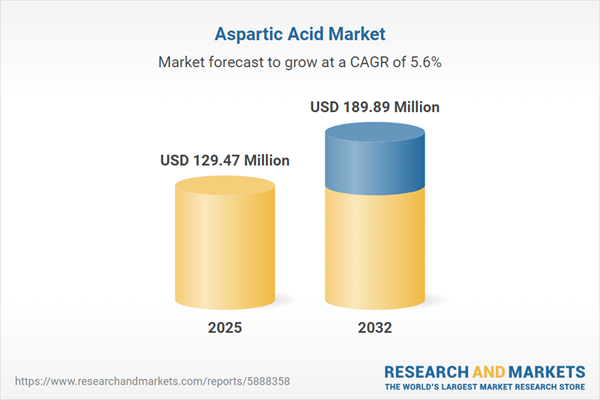Speak directly to the analyst to clarify any post sales queries you may have.
The aspartic acid market is redefining its strategic landscape through advancements in production, sustainability focus, and rising demand for high-value amino acid ingredients. Senior leadership teams face important decisions surrounding global trends, evolving customer requirements, and operational efficiency within this sector.
Market Snapshot: Aspartic Acid Market Growth and Opportunity
The global aspartic acid market expanded from USD 122.56 million in 2024 to USD 129.47 million in 2025, with projections indicating a rise to USD 189.89 million by 2032. The sector is maintaining a CAGR of 5.62%. Shifts in consumer preference toward protein-enriched offerings and a push for clean-label, bio-based ingredients continue to accelerate adoption across a spectrum of end-uses. Growth is supported by developments in food technology, personal care, nutraceuticals, and pharmaceuticals, driving new business models and cross-sector diversification. The need for sustainable manufacturing practices and high-quality ingredients is compelling organizations to adapt to regulatory changes and meet shifting global expectations.
Scope & Segmentation: Aspartic Acid Industry Analysis
- Application Sectors: Used in animal feed for aquaculture, poultry, ruminant, and swine applications; included in cosmetics targeting haircare and skincare innovation; integrated into food and beverage production such as bakery, beverages, confectionery, dairy, and meat processing; applied in nutraceuticals like dietary supplements, functional foods, and sports nutrition; essential for pharmaceuticals in injectable and oral formats.
- Product Types: Available as both liquid and powder, serving shelf-life needs and immediate-use cases in food manufacturing, healthcare, and nutrition sectors, enabling process flexibility and product adaptation.
- Production Processes: Chemical synthesis alongside fermentation methods, with fermentation highlighted for providing environmental advantages and supporting better product quality in line with long-term sustainability standards.
- Grade Classifications: Available in cosmetic, feed, food, pharma, and technical grades, each defined by strict safety and compliance protocols that address requirements from consumer markets to industrial demands.
- Distribution Channels: Offline channels such as direct sales, distributors, dealers, and retailers accommodate high-volume transactions and client relationships; online avenues and corporate platforms expand market reach and streamline procurement processes for decision-makers.
- Regional Analysis: The Americas continue to drive activity through broad adoption and supply strategies; the EMEA region places emphasis on compliance and innovation aligned to regulatory frameworks; Asia-Pacific leads with fast-paced adoption, supporting capacity growth and bridging advanced with emerging economies.
- Industry Players: Key suppliers include Ajinomoto Co., Inc.; Kyowa Hakko Bio Co., Ltd.; Meihua Group International Co., Ltd.; Yuki Gosei Kogyo Co., Ltd.; Daicel Corporation; Fujian Haohua Chemical Co., Ltd.; Hebei Jinshan Chemical Co., Ltd.; Longlive Bio-technology Co., Ltd.; Jiangsu SSJ Biotech Group Co., Ltd.; and Yantai Zhenghai Biotechnology Co., Ltd.
Key Takeaways for Senior Decision-Makers
- Accelerated adoption of fermentation and bioprocessing technologies is helping organizations meet sustainability metrics while maintaining product integrity and quality standards.
- Heightened regulations and customer expectations in personal care, pharmaceutical, and nutrition applications are driving more rigorous quality management and compliance protocols.
- Strategic market entry must align with distinct regional sustainability and regulatory requirements, necessitating tailored business development and supply chain approaches.
- Ongoing sector consolidation and increasing alliances encourage both service and product innovation, influencing how firms compete and collaborate.
- Digitalization of supply chain tools and analytics remains fundamental for navigating policy changes and ensuring operational resilience amid global trade disruptions.
Tariff Impact and Strategic Implications
New U.S. tariffs on aspartic acid imports are prompting organizations to reconfigure their supply chains. By prioritizing domestic partnerships and optimizing distribution networks, companies are securing flexible agreements and leveraging analytics for real-time decisions. Diversifying supplier networks has become pivotal for maintaining resilience and safeguarding business continuity. Firms that act swiftly to realign sourcing strategies are better positioned to manage fluctuations in international trade and enhance customer trust throughout the sector.
Methodology & Data Sources
This research integrates an established, multi-layered approach, utilizing secondary sources such as industry publications and regulatory materials, combined with primary interviews and surveys of key stakeholders. Insights undergo triangulation, advanced analytical modeling, and peer review for maximum reliability and relevance.
Aspartic Acid Market: Why This Report Matters
- Equips executive teams to anticipate technological transformation and adapt operational models by providing actionable and current market intelligence for the aspartic acid industry.
- Enables procurement, R&D, and operations leaders to build responsive supply chains, improve process efficiency, and address compliance demands with credible analysis tailored to industry needs.
- Offers regional, segmented data crucial for creating sustainable growth strategies that respond effectively to market-specific opportunities and risks.
Conclusion
The aspartic acid market’s forward direction is set by innovation, regulatory compliance, and sustainability goals. Companies relying on robust, evidence-based analysis remain best prepared to influence industry progress and secure emerging opportunities.
Additional Product Information:
- Purchase of this report includes 1 year online access with quarterly updates.
- This report can be updated on request. Please contact our Customer Experience team using the Ask a Question widget on our website.
Table of Contents
3. Executive Summary
4. Market Overview
7. Cumulative Impact of Artificial Intelligence 2025
List of Figures
Samples

LOADING...
Companies Mentioned
The key companies profiled in this Aspartic Acid market report include:- Ajinomoto Co., Inc.
- Kyowa Hakko Bio Co., Ltd.
- Meihua Group International Co., Ltd.
- Yuki Gosei Kogyo Co., Ltd.
- Daicel Corporation
- Fujian Haohua Chemical Co., Ltd.
- Hebei Jinshan Chemical Co., Ltd.
- Longlive Bio-technology Co., Ltd.
- Jiangsu SSJ Biotech Group Co., Ltd.
- Yantai Zhenghai Biotechnology Co., Ltd.
Table Information
| Report Attribute | Details |
|---|---|
| No. of Pages | 195 |
| Published | October 2025 |
| Forecast Period | 2025 - 2032 |
| Estimated Market Value ( USD | $ 129.47 Million |
| Forecasted Market Value ( USD | $ 189.89 Million |
| Compound Annual Growth Rate | 5.6% |
| Regions Covered | Global |
| No. of Companies Mentioned | 11 |









